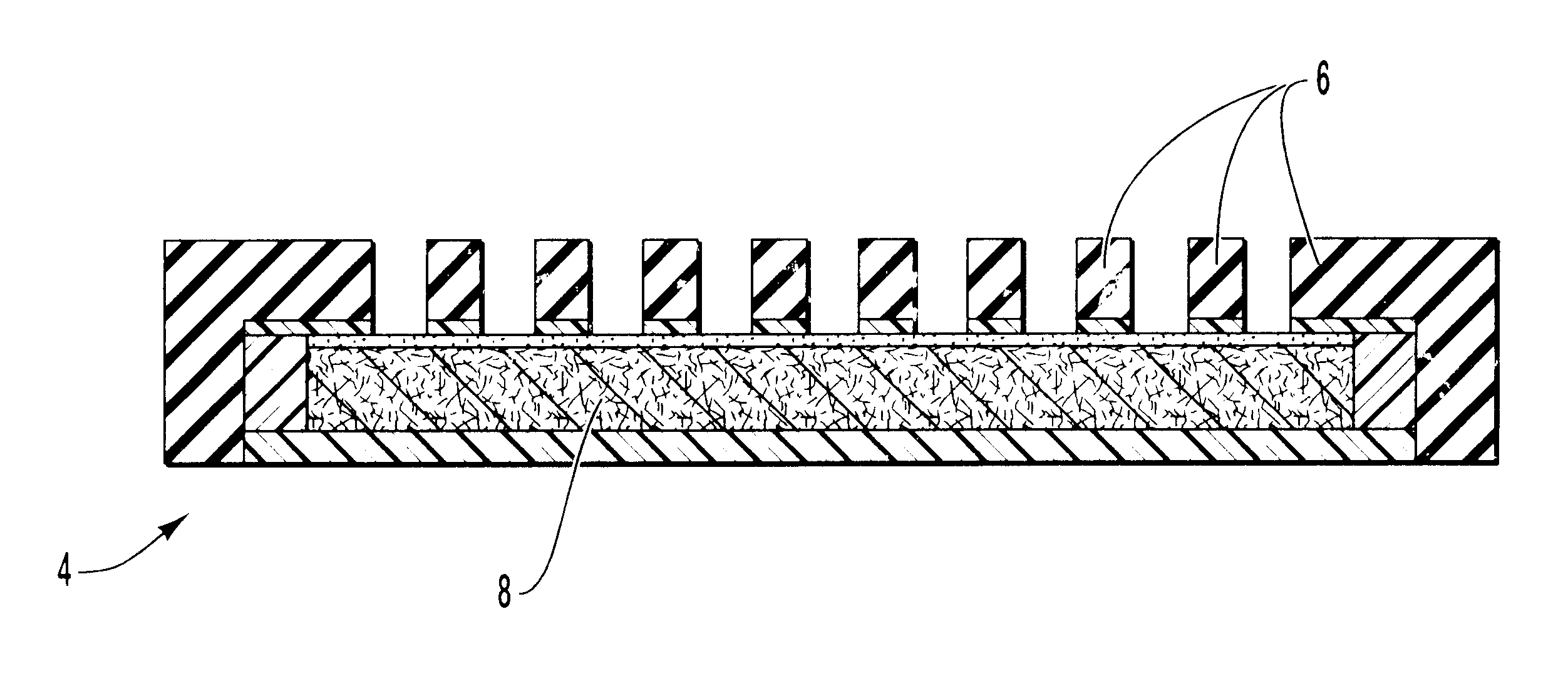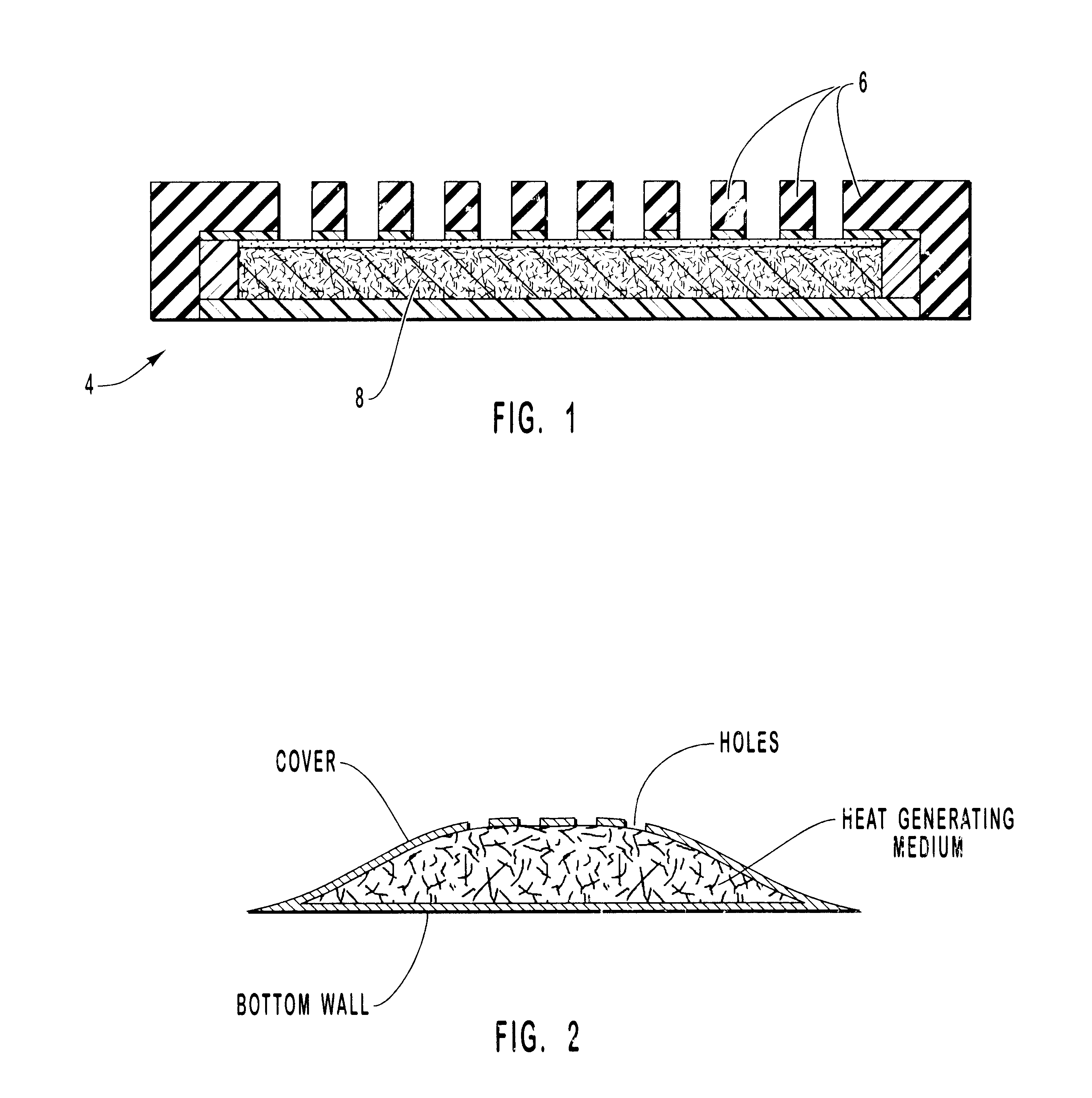Method for manufacturing a heat generating apparatus
a heat generating apparatus and manufacturing method technology, applied in the direction of packaging, liquid material, therapeutic cooling, etc., can solve the problems of insufficient heat generation duration, insufficient heat generation temperature and duration, and devices that are usually thin and compact, so as to increase the amount of heat generating medium.
- Summary
- Abstract
- Description
- Claims
- Application Information
AI Technical Summary
Benefits of technology
Problems solved by technology
Method used
Image
Examples
example 1
(Actual)
An actual heating patch was manufactured with a method described above. The steps of the process are explained below.
Step 1. Selecting An Open Chamber and Cover
An open chamber and cover suitable for medical applications were selected. The open chamber was defined by a surrounding wall and a bottom wall. The rectangular ring-shaped surrounding wall was made of a closed-cell foam tape(3M 1779), and had inner dimensions of about 1.0 inches by 1.625 inches and outer dimensions of about 1.5 inch by 2.125 inch, with 0.125 inch rounded comers. The height of the surrounding wall was 1 / 16 inch. The rectangular bottom wall was made of a thin plastic tape (3M 1525L), and had the dimensions corresponding to the outer dimensions of the surrounding wall. The bottom side of the bottom wall is adhesive. The bottom side is covered by a protective liner prior to application. The surrounding wall was adhered onto the bottom wall to form an open, shallow chamber.
The cover of the chamber was a r...
example 2
In another example, all the ingredients of the heat generating medium, except is water, are mixed to form a mixed powder. The mixed powder is then loaded directly into the open chamber as in Example 1. More specific details of the process are set forth below.
Step 1. The Open Chamber and the Cover
The open chamber is defined by a surrounding wall and a bottom wall. The rectangular ring-shaped surrounding wall is made of a closed-cell foam tape, and has inner dimensions of about 1.0 inches by 1.625 inches and outer dimensions of about 1.5 inch by 2.125 inch, with 0.125 inch rounded comers. The height of the surrounding wall is 1 / 8 inch. The rectangular bottom wall is made of a thin plastic tape and has dimensions corresponding to the outer dimensions of the surrounding wall. The surrounding wall is adhered onto the bottom wall to form a open shallow chamber. The cover of the chamber is an rectangular closed-cell foam tape with 8 holes (diameter about 1 / 16 inch). The dimensions of the c...
example 3
In another example, a manufacturing process similar to that in Example 1 is employed, except that in Step 2, the mixed powder has no sodium chloride but only activated carbon, iron powder, and wood powder in the weight ratio of about 5:16:3. Also, the proper amount of sodium chloride is dissolved in the water, and the sodium chloride in water solution, instead of water, is added into the dried, heat generating medium in Step 4. The steps of Example 1 with these variations are explained below.
Step 1. Selecting An Open Chamber and Cover
An open chamber and cover suitable for medical applications are selected. The open chamber is defined by a surrounding wall and a bottom wall. The rectangular ring-shaped surrounding wall is made of a closed-cell foam tape(3M1779), and has inner dimensions of about 1.0 inches by 1.625 inches and outer dimensions of about 1.5 inch by 2.125 inch, with 0.125 inch rounded comers. The height of the surrounding wall is 1 / 16 inch. The rectangular bottom wall i...
PUM
| Property | Measurement | Unit |
|---|---|---|
| temperatures | aaaaa | aaaaa |
| temperatures | aaaaa | aaaaa |
| area | aaaaa | aaaaa |
Abstract
Description
Claims
Application Information
 Login to View More
Login to View More - R&D
- Intellectual Property
- Life Sciences
- Materials
- Tech Scout
- Unparalleled Data Quality
- Higher Quality Content
- 60% Fewer Hallucinations
Browse by: Latest US Patents, China's latest patents, Technical Efficacy Thesaurus, Application Domain, Technology Topic, Popular Technical Reports.
© 2025 PatSnap. All rights reserved.Legal|Privacy policy|Modern Slavery Act Transparency Statement|Sitemap|About US| Contact US: help@patsnap.com


